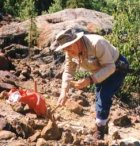|
|
|
Safe Rockhounding
By Marilyn Fraser
What is a rockhound? The term was first used for geologists in the oil fields. The geologists often smell rock samples taken from the core drillings, looking for the odour of oil. The drillers would say, "He hunts for oil like a hound dog." Thus he is a "Rockhound". Since then, anyone who collects rocks to study is called Rockhound.
| |

Rockhounding for minerals at the Ore Fault Claim near Bernic Lake, Manitoba. Photo by Dirk Schmid, ©1999.
|
During summer holidays you may be going on a field trip. There are some good rules to keep in mind when you are out hunting for rocks and minerals. Here are a few rules to keep in mind, so that you will have a good safe trip and a happy day.
Safety Rules
- Plan ahead and consider where you are going. Let someone know where you are going and when you expect to be back.
- Wear protective clothing: good sturdy footwear (preferably boots), work gloves to protect your hands, a hard hat to protect your head (your bicycle helmet is good), safety goggles to protect your eyes from flying chips of rock. Take along rain or sun protection (hat, jacket, sun screen) and drinking water. You may need a sweater if you are going to be gone all day.
- Be sure you know exactly where you are going or have a guide who does, so that you don't get lost.
- Always ask permission to go on private property such as a farm.
- Be very cautious around caves or pits and never enter old mines. There is always the danger of a rock fall or cave in.
- Do not leave litter behind. When you leave take everything you brought with you. That will keep you from leaving behind something important to you, as well.
- Always close any gates that you opened. Do not damage fencing, buildings or machinery. You want to be welcome to return again!
- Do not "move in" on someone else's spot unless invited to join them.
- Stay clear of overhanging cliffs and rock faces where there is the danger of falling rocks. Never work near a rock wall or under a cliff. Your hard hat won't protect you if a large rock falls from any height.
- Be very wary of anyone who may be working above you on a hill or dump. Be sure there is no one working below you who may be hurt by falling rocks or a tool that may fall.
- If you make any holes, be sure to fill them in before you leave. Do not leave a hole that may cause an animal such as a deer or cow to break a leg, or a hole that may trap an animal.
- Become knowledgable about first aid in the field. Carry a small first aid kit with you for cuts, scrapes, bee or hornet stings. Take a beginners course with St. John Ambulance Brigade.
- Watch out for small children and keep them in sight at all times.
- Do not damage any trees or the environment.
- Take along a supply of insect repellent. Black flies and mosquitoes can make your day very unpleasant. Watch for any wasps or hornets nests and beehives and avoid them.
- Always know about the hazards of the area where you will be hunting.
Have a safe and happy time collecting.
Copyright ©1998 Marilyn Fraser
E-mail: silver@tor.axxent.ca
This article may not be copied, distributed or reprinted in any form without the author's permission. To contact the author, please use the e-mail address provided. If you are unable to contact the author, please contact the Canadian Rockhound. Authorized reprints must acknowledge the author, original source and the Canadian Rockhound, and include the website URL address of the Canadian Rockhound.
Top of Page
|


